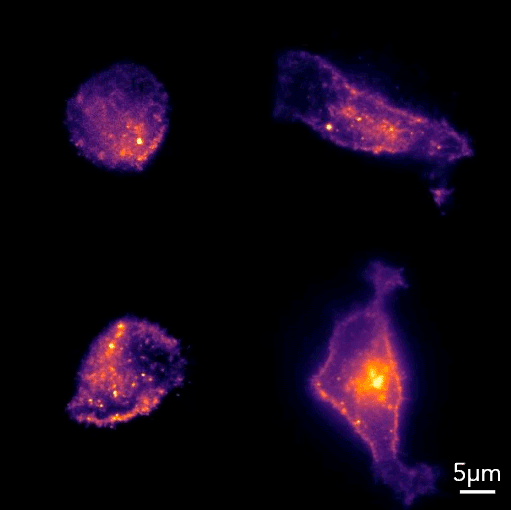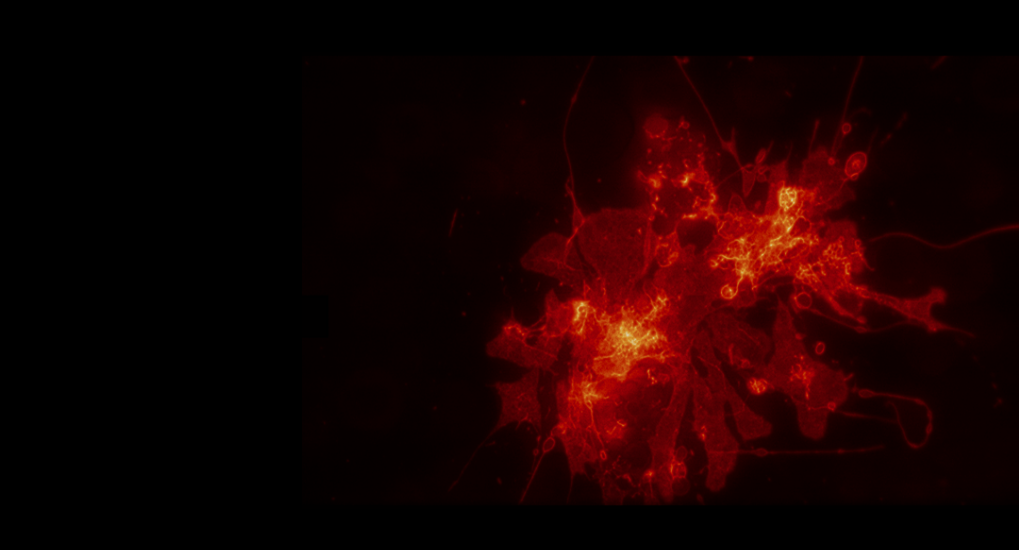Upcoming Virtual dSTORM Training – Coming January 29, 2026 register now>
Fluorescence microscopy
Simple Overview
What is fluorescence microscopy?
Fluorescence microscopy is an imaging technique used in light microscopes that allows the excitation of fluorophores and subsequent detection of the fluorescence signal. Fluorescence is produced when light excites or moves an electron to a higher energy state, immediately generating light of a longer wavelength, lower energy and different color to the original light absorbed.
To visualize labeled molecules in the sample, fluorescence microscopes require a very powerful light source and a dichroic mirror to reflect light at the desired excitation/emission wavelength. The filtered excitation light then passes through the objective to be focused onto the sample and the emitted light is filtered back onto the detector for image digitalization.

Cells of neuroendocrine origin (pc12 cells), expressing CD63 tagged with pHluorin. Professor Michelle Knowles and Anarkali Mahmood from the University of Denver
Why is fluorescence microscopy useful?
Fluorescence microscopy is highly sensitive, specific, reliable and extensively used by scientists to observe the localization of molecules within cells, and of cells within tissues. Fluorescence imaging is reasonably gentle on the sample, which facilitates the visualization of molecules and dynamic processes in live cells. In conventional fluorescence microscopes, the light beam penetrates the full depth of the sample, allowing easy imaging of intense signals and co-localization studies with multi-colored fluorophores on the same sample.
Fluorescence microscopy can, however, limit the precise localization of fluorescence molecules, as any out-of-focus light will be collected. This can be resolved by using super-resolution techniques, which circumvent the limited resolution power of conventional fluorescence microscopy, which cannot distinguish objects that are less than 200 nm apart.
Can I do fluorescence microscopy on the Nanoimager?
The Nanoimager is a compact microscope that allows powerful imaging of fluorescence molecules with enhanced resolution and enriched visualization by using different super-resolution techniques, including dSTORM, PALM, single-particle tracking and smFRET. The Nanoimager relies on different modes of imaging, depending on the sample and optimal signal to noise ratio, and can use three illumination modes: epifluorescence, TIRF or HILO.
With the Nanoimager, two fluorophores can be captured simultaneously to improve understanding of how different molecules interact and with a total of four different fluorophores (four laser colors) to be used in a single sample. The Nanoimager significantly improves the resolution of fluorescence microscopy to up to 20 nm and provides unrivalled stability, allowing the microscope to be used in any lab environment.
Learn more about the Nanoimager’s illumination modes and the super-resolution microscopy techniques it supports.

PDZD8 protein walking along the ER in fibroblast cells in close vicinity of Mitochondria, Dr. Xufeng Wu, NIH, Bethesda

